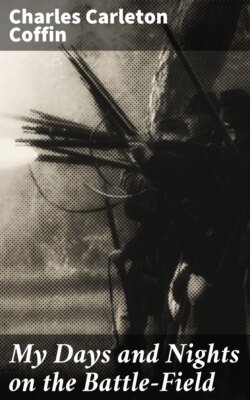Читать книгу My Days and Nights on the Battle-Field - Charles Carleton Coffin - Страница 4
На сайте Литреса книга снята с продажи.
MILITARY TERMS.
ОглавлениеTable of Contents
Abatis.—Trees cut down, their branches made sharp, and used to block a road, or placed in front of fortifications.
Advance.—Any portion of an army which is in front of the rest.
Aides-de-camp.—Officers selected by general officers to assist them in their military duties.
Ambulances.—Carriages for the sick and wounded.
Battery.—A battery consists of one or more pieces of artillery. A full battery of field artillery consists of six cannon.
Battalion.—A battalion consists of two or more companies, but less than a regiment.
Bombardment.—Throwing shot or shells into a fort or earthwork.
Canister.—A tin cylinder filled with cast-iron shot. When the gun is fired, the cylinder bursts and scatters the shot over a wide surface of ground.
Caisson.—An artillery carriage, containing ammunition for immediate use.
Casemate.—A covered chamber in fortifications, protected by earth from shot and shells.
Columbiad.—A cannon, invented by Colonel Bomford, of very large calibre, used for throwing shot or shells. A ten-inch columbiad weighs 15,400 pounds, and is ten and a half feet long.
Column.—A position in which troops may be placed. A column en route is the order in which they march from one part of the country to another. A column of attack is the order in which they go into battle.
Countersign.—A particular word given out by the highest officer in command, intrusted to guards, pickets, and sentinels, and to those who may have occasion to pass them.
Embrasure.—An opening cut in embankments for the muzzles of the cannon.
Enfilade.—To sweep the whole length of the inside of a fortification or a line of troops.
Field-Works.—An embankment of earth excavated from a ditch surrounding a town or a fort.
Flank.—The right or left side of a body of men, or place. When it is said that the enemy by a flank march outflanked our right wing, it is understood that he put himself on our right hand. When two armies stand face to face the right flank of one is opposite the left flank of the other.
File.—Two soldiers—a front rank and a rear rank man.
Fuse.—A slow-burning composition in shells, set on fire by the flash of the cannon. The length of the fuse is proportioned to the intended range of the shells.
Grape.—A large number of small balls tied up in a bag.
Howitzer.—A cannon of large calibre and short range, commonly used for throwing shells, grape, and canister.
Limber.—The fore part of a field gun-carriage, to which the horses are attached. It has two wheels, and carries ammunition the same as the caisson.
Pontoon.—A bridge of boats for crossing streams, which may be carried in wagons.
Parabola.—The curve described by a shell in the air.
Range.—The distance to which shot, shells, or bullets may be fired.
Reveille.—The first drum-beat in the morning.
Rifle-Pits.—Excavations in the earth or other shelter for riflemen.
Spherical Case.—A thin shell of cast-iron filled with bullets, with a fuse, and a charge of powder sufficient to burst it. It contains about ninety bullets.
Wings.—The right and left divisions of a body of troops, distinguished from the centre.
